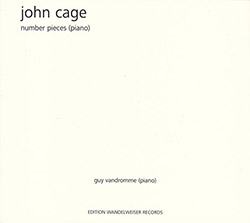
There can be no doubt that John Cage has been a composer of considerable importance to the Wandelweiser group, its composers and performers. By an accident of history, Wandelweiser was formed in 1992 and Cage died in August of that year, less than a month short of his eightieth birthday; but for that, it seems highly likely that he would have been actively involved with Wandelweiser. Nonetheless, Cage's music has been well represented on the label; from 1996 and its very first album Accordion Music — on which "Cheap Imitation" (1969) by Cage, and compositions by Jürg Frey, Michael Pisaro and Antoine Beuger, were played on accordion and flute — right up to the current album, which keeps Cage's tally of Wandelweiser releases ahead of fellow label stalwarts Frey, Pisaro and Beuger.
Cage's Wandelweiser albums cover a broad spectrum of his music; 2007's Early Music, also played on accordion, delved as far back as 1948 for "Dream" and "In A Landscape", neither of which has a hint of a Cageian silence; 2011's Empty Words featured the 1974 experimental text piece of the title. Number Pieces (Piano) is certainly not the first Wandelweiser album to feature examples of the number pieces which Cage wrote in the last six years of his life; 2004's double-CD One⁹ consisted of ten solo accordion realisations of the 1991 title piece, while 2006's For Seven Players had a fine septet version of "Seven" (1988).
As its title asserts, the tracks on Number Pieces (Piano) were all played on piano, with the Belgian pianist-conductor Guy Vandromme featuring on another Wandelweiser CD to go alongside his 2018 recording of Satie's Socrate. Recorded in November 2013, the music here consists of two versions of Cage's "One" and a single version of his "One⁵", the titles' main word indicating they were written for one player, and the small power five that it was Cage's fifth such number piece. (The majority of Cage's number pieces are for one player). Like many of the number pieces, "One" and "One⁵" both feature flexible time brackets during which the performer can use their discretion and play the given notes whenever seems appropriate. So, "One" has ten such brackets, of which nine are flexible, each being roughly a minute long. Each bracket contains two sets of chords; the order of each set is maintained, but the relationship between the two sets is chosen by the pianist. Such instructions click into focus and make perfect sense when the two versions of "One" are played simultaneously or otherwise compared; although they are obviously versions of the same piece, the chords can differ in volume depending on the force used, in duration depending on use of the sustain pedal, and in other ways too. Despite such possibilities, the two versions here clock-in within nine seconds of one another. In contrast, "One⁵" has separate brackets for left and right hands, twenty-one for the former, twenty-four for the latter, so there are overlaps within and between brackets. Each bracket contains one, two or three notes, making the piece more spacious and reflective than "One", particularly when the sustain pedal is used, as recommended by Cage. There are occasional pregnant silences punctuating the piece, and serving as a reminder of the bond between the composer and the label. Altogether, this is an excellent album, a welcome addition both to the Wandelweiser catalogue and the Cage canon.
Comments and Feedback:
|



